engine MITSUBISHI SHOGUN 2003 (in English) Manual PDF
[x] Cancel search | Manufacturer: MITSUBISHI, Model Year: 2003, Model line: SHOGUN, Model: MITSUBISHI SHOGUN 2003Pages: 392, PDF Size: 14.34 MB
Page 269 of 392
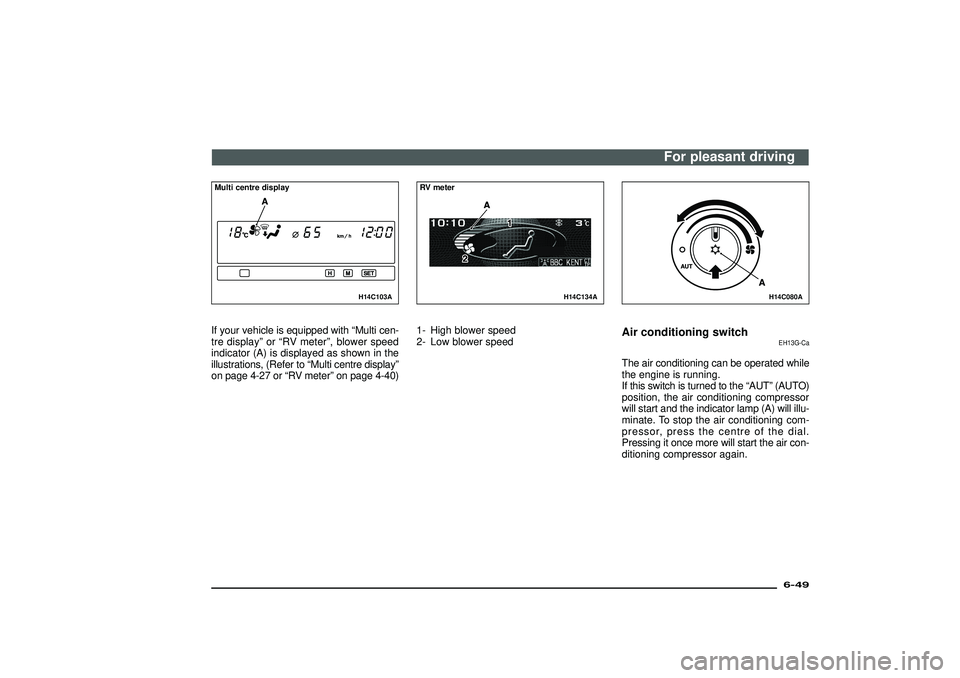
H14C103A
Multi centre displayIf your vehicle is equipped with“Multi cen-
tre display”or“RV meter”, blower speed
indicator (A) is displayed as shown in the
illustrations, (Refer to“Multi centre display”
on page 4-27 or“RV meter”on page 4-40)
H14C134A
RV meter1- High blower speed
2- Low blower speed
H14C080A
Air conditioning switch
EH13G-Ca
The air conditioning can be operated while
the engine is running.
If this switch is turned to the“AUT”(AUTO)
position, the air conditioning compressor
will start and the indicator lamp (A) will illu-
minate. To stop the air conditioning com-
pressor, press the centre of the dial.
Pressing it once more will start the air con-
ditioning compressor again.
For pleasant driving
6-49
Div:
Out put date:
Page 270 of 392
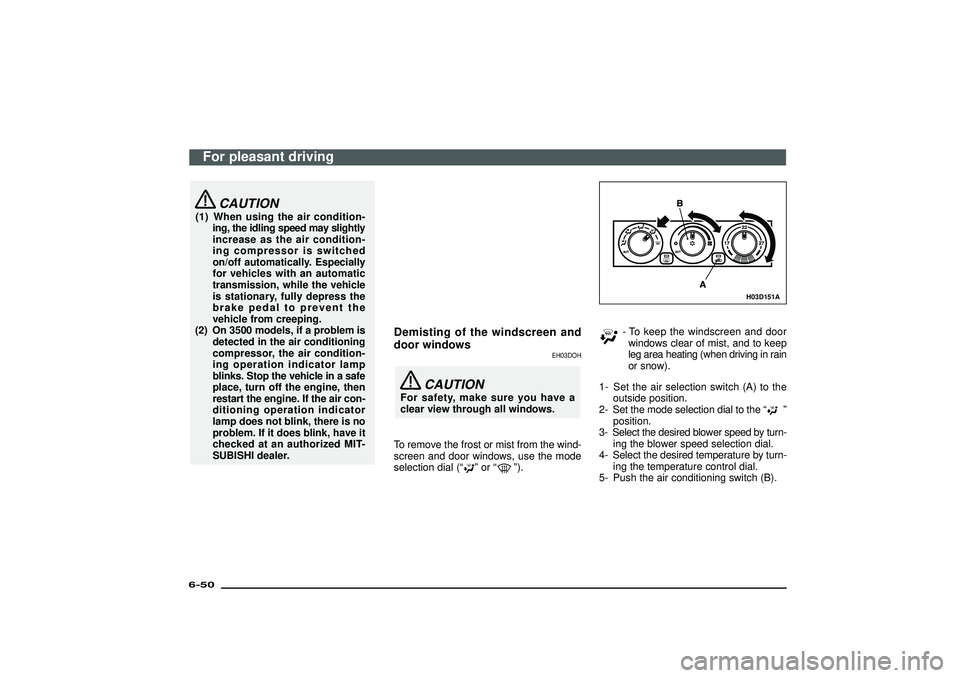
CAUTION
(1) When using the air condition-
ing, the idling speed may slightly
increase as the air condition-
ing compressor is switched
on/off automatically. Especially
for vehicles with an automatic
transmission, while the vehicle
is stationary, fully depress the
brake pedal to prevent the
vehicle from creeping.
(2) On 3500 models, if a problem is
detected in the air conditioning
compressor, the air condition-
ing operation indicator lamp
blinks. Stop the vehicle in a safe
place, turn off the engine, then
restart the engine. If the air con-
ditioning operation indicator
lamp does not blink, there is no
problem. If it does blink, have it
checked at an authorized MIT-
SUBISHI dealer.
Demisting of the windscreen and
door windows
EH03DOH
CAUTION
For safety, make sure you have a
clear view through all windows.
To remove the frost or mist from the wind-
screen and door windows, use the mode
selection dial (“
”or“
”).
H03D151A
- To keep the windscreen and door
windows clear of mist, and to keep
leg area heating (when driving in rain
or snow).
1- Set the air selection switch (A) to the
outside position.
2- Set the mode selection dial to the“
”
position.
3- Select the desired blower speed by turn-
ing the blower speed selection dial.
4- Select the desired temperature by turn-
ing the temperature control dial.
5- Push the air conditioning switch (B).
For pleasant driving
6-50Div:
Out put date:
Page 271 of 392
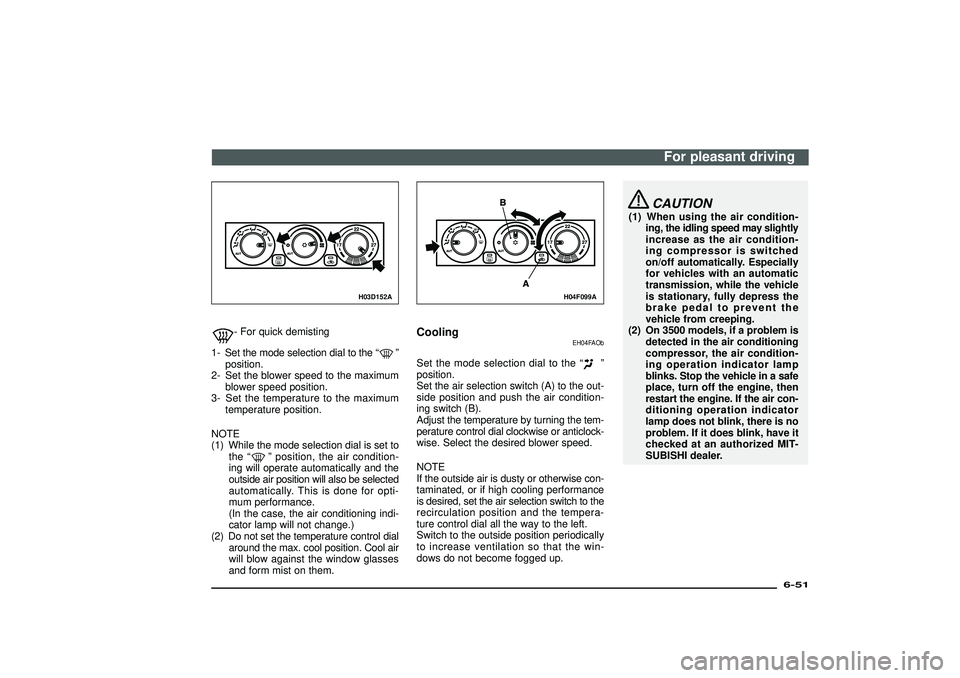
H03D152A
- For quick demisting
1- Set the mode selection dial to the“
”
position.
2- Set the blower speed to the maximum
blower speed position.
3- Set the temperature to the maximum
temperature position.
NOTE
(1) While the mode selection dial is set to
the“
”position, the air condition-
ing will operate automatically and the
outside air position will also be selected
automatically. This is done for opti-
mum performance.
(In the case, the air conditioning indi-
cator lamp will not change.)
(2) Do not set the temperature control dial
around the max. cool position. Cool air
will blow against the window glasses
and form mist on them.
H04F099A
Cooling
EH04FAOb
Set the mode selection dial to the“
”
position.
Set the air selection switch (A) to the out-
side position and push the air condition-
ing switch (B).
Adjust the temperature by turning the tem-
perature control dial clockwise or anticlock-
wise. Select the desired blower speed.
NOTE
If the outside air is dusty or otherwise con-
taminated, or if high cooling performance
is desired, set the air selection switch to the
recirculation position and the tempera-
ture control dial all the way to the left.
Switch to the outside position periodically
to increase ventilation so that the win-
dows do not become fogged up.
CAUTION
(1) When using the air condition-
ing, the idling speed may slightly
increase as the air condition-
ing compressor is switched
on/off automatically. Especially
for vehicles with an automatic
transmission, while the vehicle
is stationary, fully depress the
brake pedal to prevent the
vehicle from creeping.
(2) On 3500 models, if a problem is
detected in the air conditioning
compressor, the air condition-
ing operation indicator lamp
blinks. Stop the vehicle in a safe
place, turn off the engine, then
restart the engine. If the air con-
ditioning operation indicator
lamp does not blink, there is no
problem. If it does blink, have it
checked at an authorized MIT-
SUBISHI dealer.
For pleasant driving
6-51
Div:
Out put date:
Page 274 of 392

Changing the temperature
EH18BOI
Select the desired temperature level by
turning clockwise or anticlockwise.
NOTE
The type C or type D rear air conditioning
will not operate unless the front air condi-
tioning compressor is operating. Always
switch the front air conditioning compres-
sor on before using the air conditioning. If
the front air conditioning compressor is not
operating, the system will just operate as
a blower.
H18A139E
Type A, B, DThe temperature will gradually increase as
the dial is turned to the right.
NOTE
When the engine coolant temperature is
low, temperature of air introduced into the
passenger compartment does not change
even if the temperature control dial is
moved to the high temperature side.
For pleasant driving
6-54Div:
Out put date:
Page 279 of 392
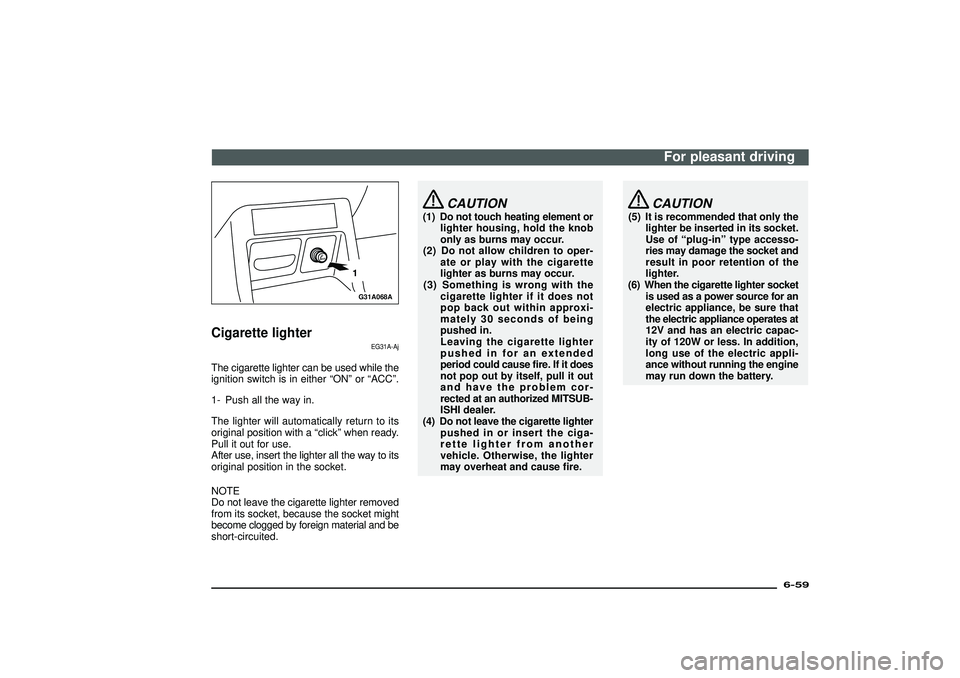
G31A068A
Cigarette lighter
EG31A-Aj
The cigarette lighter can be used while the
ignition switch is in either“ON”or“ACC”.
1- Push all the way in.
The lighter will automatically return to its
original position with a“click”when ready.
Pull it out for use.
After use, insert the lighter all the way to its
original position in the socket.
NOTE
Do not leave the cigarette lighter removed
from its socket, because the socket might
become clogged by foreign material and be
short-circuited.
CAUTION
(1) Do not touch heating element or
lighter housing, hold the knob
only as burns may occur.
(2) Do not allow children to oper-
ate or play with the cigarette
lighter as burns may occur.
(3) Something is wrong with the
cigarette lighter if it does not
pop back out within approxi-
mately 30 seconds of being
pushed in.
Leaving the cigarette lighter
pushed in for an extended
period could cause fire. If it does
not pop out by itself, pull it out
and have the problem cor-
rected at an authorized MITSUB-
ISHI dealer.
(4) Do not leave the cigarette lighter
pushed in or insert the ciga-
rette lighter from another
vehicle. Otherwise, the lighter
may overheat and cause fire.
CAUTION
(5) It is recommended that only the
lighter be inserted in its socket.
Use of“plug-in”type accesso-
ries may damage the socket and
result in poor retention of the
lighter.
(6) When the cigarette lighter socket
is used as a power source for an
electric appliance, be sure that
the electric appliance operates at
12V and has an electric capac-
ity of 120W or less. In addition,
long use of the electric appli-
ance without running the engine
may run down the battery.
For pleasant driving
6-59
Div:
Out put date:
Page 282 of 392
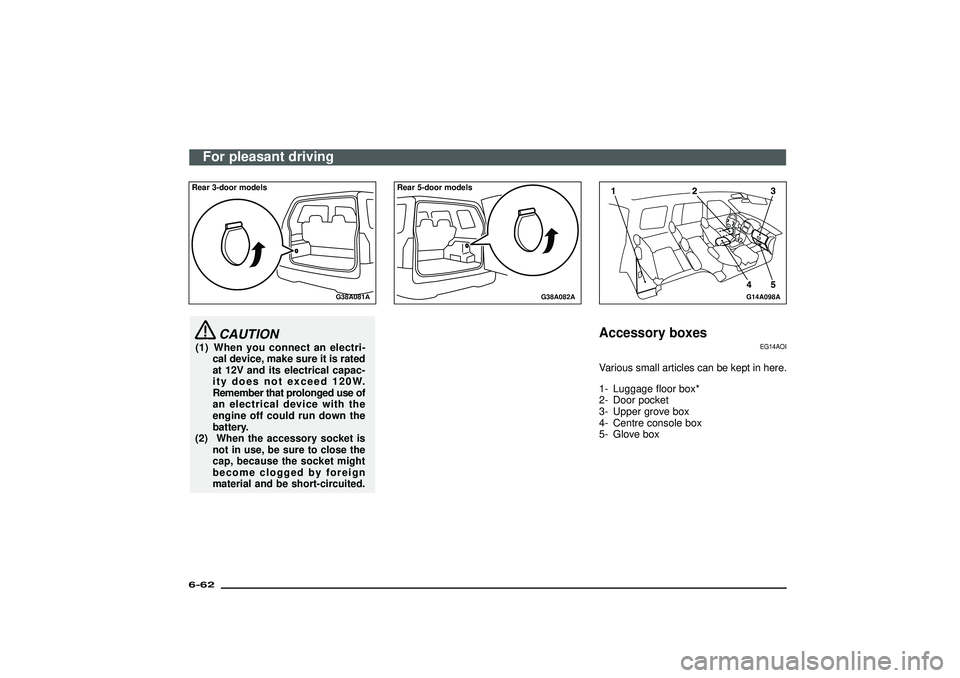
G38A081A
Rear 3-door models
CAUTION
(1) When you connect an electri-
cal device, make sure it is rated
at 12V and its electrical capac-
ity does not exceed 120W.
Remember that prolonged use of
an electrical device with the
engine off could run down the
battery.
(2)
When the accessory socket is
not in use, be sure to close the
cap, because the socket might
become clogged by foreign
material and be short-circuited.
G38A082A
Rear 5-door models
G14A098A
Accessory boxes
EG14AOI
Various small articles can be kept in here.
1- Luggage floor box*
2- Door pocket
3- Upper grove box
4- Centre console box
5- Glove box
For pleasant driving
6-62Div:
Out put date:
Page 294 of 392
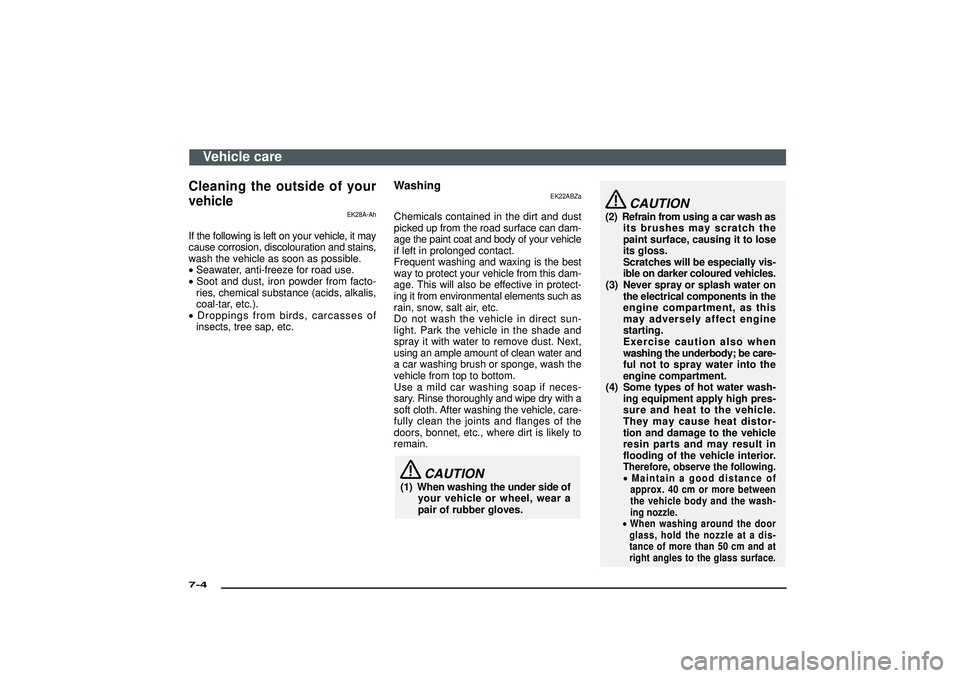
Cleaning the outside of your
vehicle
EK28A-Ah
If the following is left on your vehicle, it may
cause corrosion, discolouration and stains,
wash the vehicle as soon as possible.
•Seawater, anti-freeze for road use.
•Soot and dust, iron powder from facto-
ries, chemical substance (acids, alkalis,
coal-tar, etc.).
•Droppings from birds, carcasses of
insects, tree sap, etc.
Washing
EK22ABZa
Chemicals contained in the dirt and dust
picked up from the road surface can dam-
age the paint coat and body of your vehicle
if left in prolonged contact.
Frequent washing and waxing is the best
way to protect your vehicle from this dam-
age. This will also be effective in protect-
ing it from environmental elements such as
rain, snow, salt air, etc.
Do not wash the vehicle in direct sun-
light. Park the vehicle in the shade and
spray it with water to remove dust. Next,
using an ample amount of clean water and
a car washing brush or sponge, wash the
vehicle from top to bottom.
Use a mild car washing soap if neces-
sary. Rinse thoroughly and wipe dry with a
soft cloth. After washing the vehicle, care-
fully clean the joints and flanges of the
doors, bonnet, etc., where dirt is likely to
remain.
CAUTION
(1) When washing the under side of
your vehicle or wheel, wear a
pair of rubber gloves.
CAUTION
(2) Refrain from using a car wash as
its brushes may scratch the
paint surface, causing it to lose
its gloss.
Scratches will be especially vis-
ible on darker coloured vehicles.
(3) Never spray or splash water on
the electrical components in the
engine compartment, as this
may adversely affect engine
starting.
Exercise caution also when
washing the underbody; be care-
ful not to spray water into the
engine compartment.
(4) Some types of hot water wash-
ing equipment apply high pres-
sure and heat to the vehicle.
They may cause heat distor-
tion and damage to the vehicle
resin parts and may result in
flooding of the vehicle interior.
Therefore, observe the following.
•Maintain a good distance of
approx. 40 cm or more between
the vehicle body and the wash-
ing nozzle.
•When washing around the door
glass, hold the nozzle at a dis-
tance of more than 50 cm and at
right angles to the glass surface.
Vehicle care
7-4Div:
Out put date:
Page 296 of 392
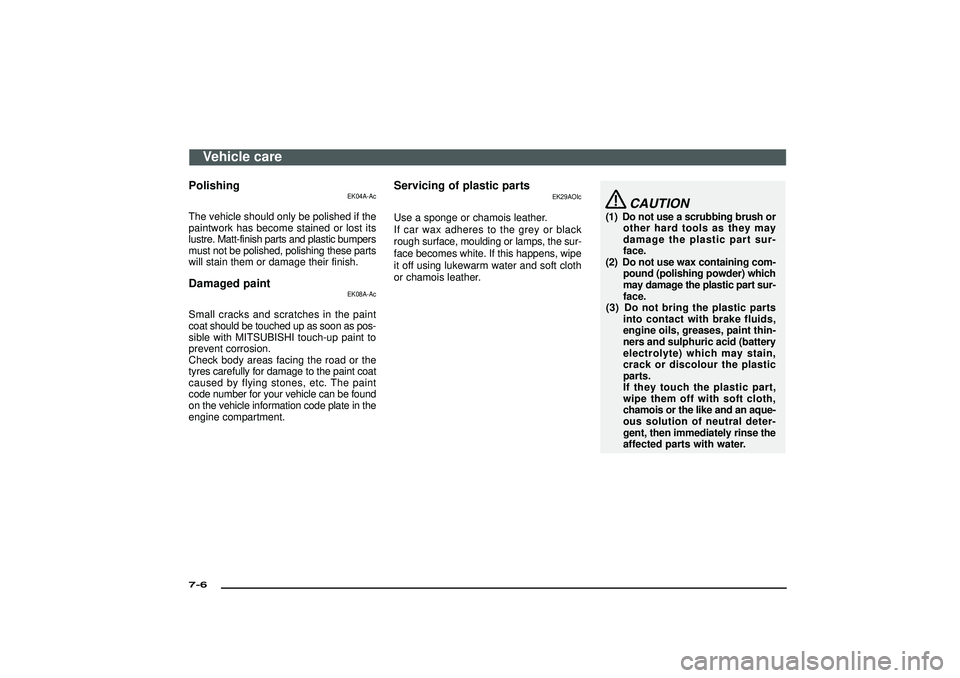
Polishing
EK04A-Ac
The vehicle should only be polished if the
paintwork has become stained or lost its
lustre. Matt-finish parts and plastic bumpers
must not be polished, polishing these parts
will stain them or damage their finish.Damaged paint
EK08A-Ac
Small cracks and scratches in the paint
coat should be touched up as soon as pos-
sible with MITSUBISHI touch-up paint to
prevent corrosion.
Check body areas facing the road or the
tyres carefully for damage to the paint coat
caused by flying stones, etc. The paint
code number for your vehicle can be found
on the vehicle information code plate in the
engine compartment.
Servicing of plastic parts
EK29AOIc
Use a sponge or chamois leather.
If car wax adheres to the grey or black
rough surface, moulding or lamps, the sur-
face becomes white. If this happens, wipe
it off using lukewarm water and soft cloth
or chamois leather.
CAUTION
(1) Do not use a scrubbing brush or
other hard tools as they may
damage the plastic part sur-
face.
(2) Do not use wax containing com-
pound (polishing powder) which
may damage the plastic part sur-
face.
(3) Do not bring the plastic parts
into contact with brake fluids,
engine oils, greases, paint thin-
ners and sulphuric acid (battery
electrolyte) which may stain,
crack or discolour the plastic
parts.
If they touch the plastic part,
wipe them off with soft cloth,
chamois or the like and an aque-
ous solution of neutral deter-
gent, then immediately rinse the
affected parts with water.
Vehicle care
7-6Div:
Out put date:
Page 298 of 392
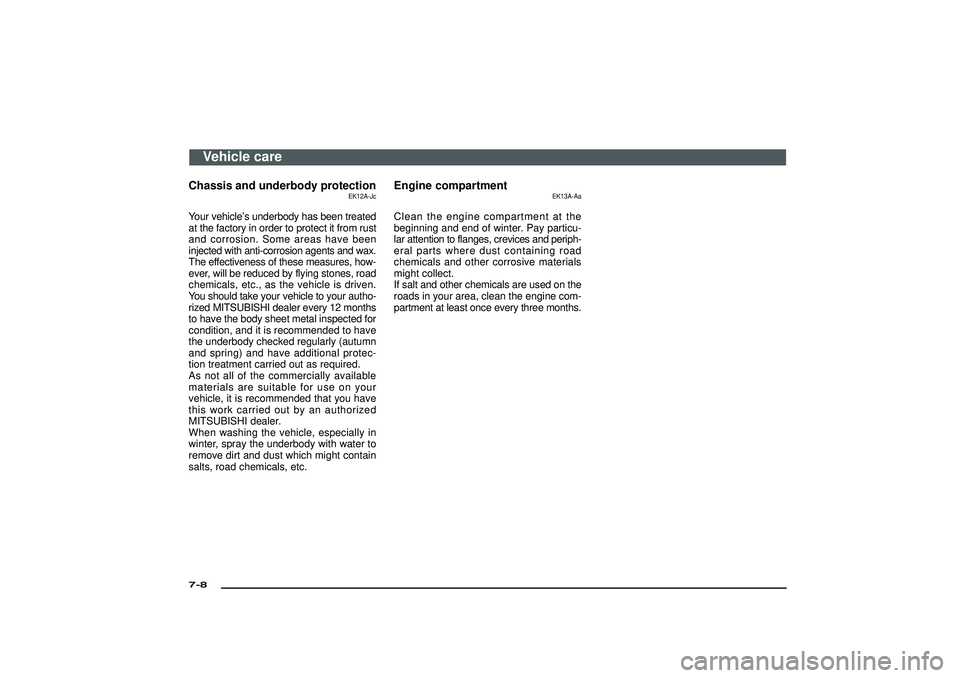
Chassis and underbody protection
EK12A-Jc
Your vehicle’s underbody has been treated
at the factory in order to protect it from rust
and corrosion. Some areas have been
injected with anti-corrosion agents and wax.
The effectiveness of these measures, how-
ever, will be reduced by flying stones, road
chemicals, etc., as the vehicle is driven.
You should take your vehicle to your autho-
rized MITSUBISHI dealer every 12 months
to have the body sheet metal inspected for
condition, and it is recommended to have
the underbody checked regularly (autumn
and spring) and have additional protec-
tion treatment carried out as required.
As not all of the commercially available
materials are suitable for use on your
vehicle, it is recommended that you have
this work carried out by an authorized
MITSUBISHI dealer.
When washing the vehicle, especially in
winter, spray the underbody with water to
remove dirt and dust which might contain
salts, road chemicals, etc.
Engine compartment
EK13A-Aa
Clean the engine compartment at the
beginning and end of winter. Pay particu-
lar attention to flanges, crevices and periph-
eral parts where dust containing road
chemicals and other corrosive materials
might collect.
If salt and other chemicals are used on the
roads in your area, clean the engine com-
partment at least once every three months.
Vehicle care
7-8Div:
Out put date:
Page 299 of 392

For emergencies
If the vehicle breaks down .................................... 8- 2
Operation under adverse driving
conditions .......................................................... 8- 2
Tools and jack ....................................................... 8- 3
Jack and jack handle ............................................ 8- 5
Jacking up the vehicle .......................................... 8- 8
Spare wheel ........................................................... 8-11
If a tyre is punctured ............................................. 8-13
Towing .................................................................... 8-17
Engine overheating................................................ 8-21
Bleeding the fuel system
(diesel-powered vehicles only) ........................ 8-23
Removal of water from the fuel filter
(diesel- powered vehicles only) ....................... 8-24
Emergency starting .............................................. 8-25
What to do if the engine speed becomes
unstable after the battery is replaced ............. 8-28
Fuses ...................................................................... 8-28
Changing a fuse ..................................................... 8-33
Replacement of lamp bulbs .................................. 8-34
Div:
Out put date: